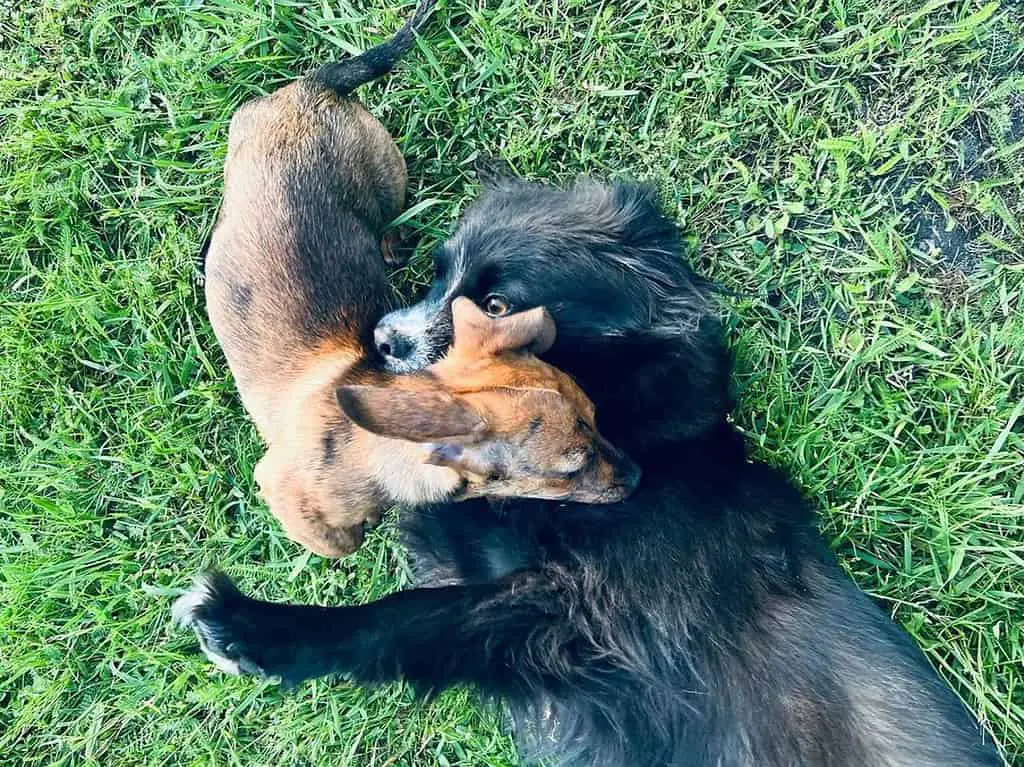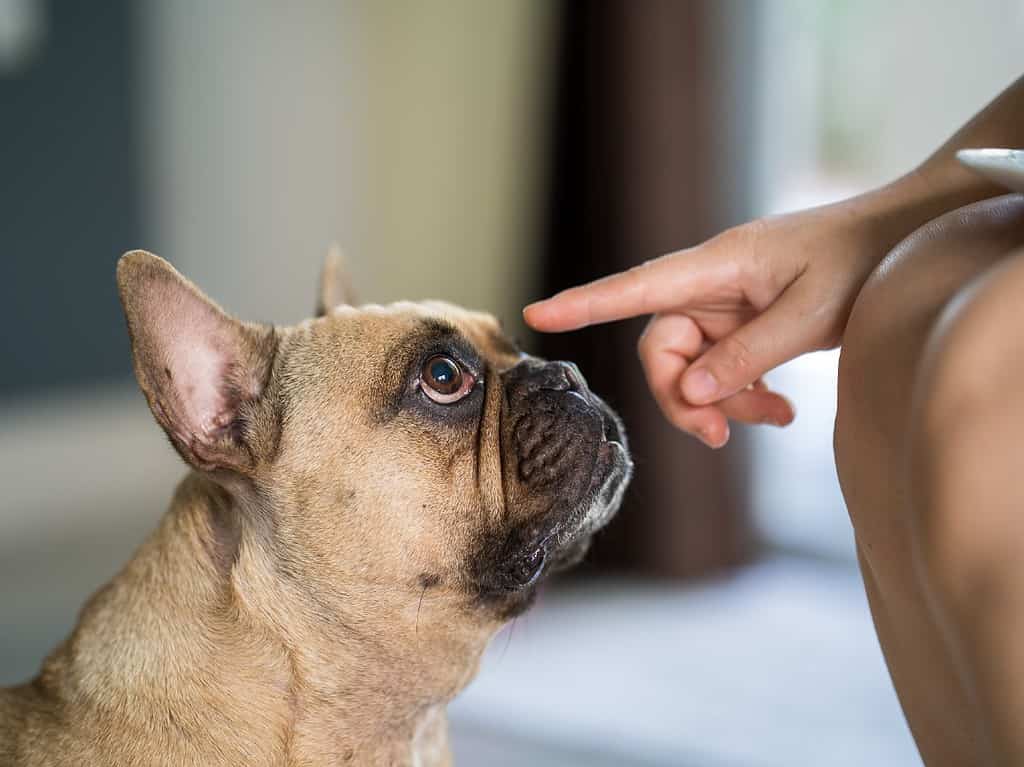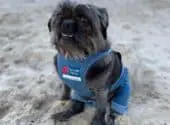It is not an uncommon scenario to witness within a dog park; two dogs playfully chase each other, nipping at each other’s necks. But have you ever wondered why do dogs bite each other’s necks? Is it simply recreational, or is there a deeper meaning behind this behavior?
This article offers an in-depth exploration of the various motivations behind dogs biting each other’s necks. We investigate the instinctive acts that can prompt this behavior and its significance in social communication among dogs. Through this examination, we hope to bring greater clarity and understanding to seemingly peculiar canine behavior.
Now let’s get to it:

Dogs bite each other’s necks to relieve teething discomfort
At the age of 3-6 months, puppies endure distress due to the emergence of their adult teeth as they replace their tiny baby teeth. This discomfort in their gums is often relieved by them biting one another’s necks. This instinctive behavior is a method used to massage and lessen any inflammation present in their gums.
Dogs will often bite at the necks of their siblings or other dogs while teething as a way to soothe any pain they may be feeling. This behavior is frequently seen during play between dogs and during socialization within a group setting. While it may appear aggressive from an outside perspective, it is a normal occurrence for puppies as they cope with the distress caused by puppy teething.
Dogs bite each other’s necks to express themselves.
Dogs use various behaviors to express themselves when communicating with one another, and neck biting is among the most common. This behavior might seem aggressive or surprising to humans, though it should be recognized that neck biting constitutes a normal form of interaction between dogs. Through this mode of communication, dogs can send and understand various messages.
Additionally, neck biting may be used to communicate under more intense circumstances. For example, while engaged in a disagreement, dogs may bite the neck to indicate their feelings of discontent and desire that the other animal keeps its distance. This manner of expression can signify a warning or displeasure with the current situation.
Why do dogs bite each other’s necks: to show dominance
Dogs may bite each other’s necks to assert dominance within social groups. This behavior is most prevalently seen during moments of competition between dogs, such as when they compete for a key position within a pack or group. Thus, the neck-biting behavior functions as a quick demonstration of superiority.
Canine behavior is strongly rooted in wild instincts. An example of this can be seen with the act of neck biting, which signifies a dog’s dominance over another pack member or individual. This powerful and symbolic gesture implies authority and control, reminiscent of its ancestor’s inclination to hunt for survival. As such, it clearly communicates the hierarchy in wolf packs – denoting an individual as the alpha or leader.
Female dogs may bite the necks of their puppies as part of maternal care
A common behavior observed among female dogs, the maternal care act of neck biting, may appear aggressive. This practice is a natural and instinctual display of affection with multiple benefits. When a mother dog bites the necks of her puppies, it fulfills various critical functions.
Initially, the mother dog will grasp their necks gently to move her puppies to a secure location or provide necessary nourishment. Subsequently, this behavior encourages the puppies to nurse, stimulating them to attach to her nipples when she bites their necks. This nursing action helps guarantee the development and health of these puppies.
Additionally, the act of biting the neck of puppies by female dogs is part of their maternal instinct and serves as an essential tool for initiating boundaries and discipline. This behavior teaches critical social lessons which are vital to a puppy’s development, allowing them to interact more effectively with other dogs in later life. Therefore, nurturing mothers’ guidance is necessary for proper growth and care despite its rough nature.
During mating, male dogs may bite the necks of female dogs as part of the breeding process.
The act of biting the neck provides a mechanism for successful mating. It establishes dominance and control in the male dog, allowing him to assert himself as the head of the pack and ensuring compliance throughout copulation. The secure hold offered by grasping the female’s neck gives him leverage to keep her steady during breeding.
Biting may appear aggressive or uncomfortable to humans, but it is a normal and natural behavior for dogs during mating. Consequently, efforts to intervene during mating should be avoided as this intrusion could potentially provoke emotional distress and impede successful reproduction.
Why do dogs bite each other’s necks: As a form of play for dogs
During playtime, dogs use their mouths to interact. This frequently entails the pups giving each other non-harmful bites around the neck, usually in conjunction with activities such as chasing, barking, and wagging their tails. This displays that the dogs are not trying to threaten or intimidate each other but instead engaging positively with each other.
Playful vs Aggressive neck biting
In situations of conflict, dominance or territorial disputes, dogs may employ forceful and intense neck biting as a display of power and aggression to establish dominance over the other dog. Such behavior can be dangerous since it is meant to intimidate, harm, or defeat the opponent. Injury and harm can result from such aggressive neck biting.
It is important to differentiate between playful and aggressive neck biting to improve interaction safety. Playful neck biting is characterized by a lighthearted atmosphere and mutual engagement and aspires towards strengthening social relationships; in contrast, aggressive neck biting aims at dominance and has the potential to cause harm. The intent behind each behavior can be deduced from analyzing facial expressions, body language, and vocalizations. To maximize protection within an interaction, recognizing the signs of aggression or playfulness should be done promptly so that an appropriate response may be taken.
How To Stop Aggressive Neck Biting In Dogs
Aggressive neck biting in dogs should be considered a serious issue that should be dealt with quickly. Understanding the motivation for this behavior is essential so that appropriate steps to modify it can be taken. Professional instruction from a certified dog trainer or an experienced vet is essential for successfully mapping out and implementing an effective strategy.
Aggression displayed through neck biting in dogs is often the result of fear and anxiety. Providing a secure and peaceful atmosphere for the dog is essential in such cases. Positive reinforcement training strategies can help promote trust and confidence within an animal, thereby lessening its fear-related aggression.
It is also possible that possessiveness or resource guarding may be prompting aggressive neck biting in dogs. The only way to properly address this issue is by providing the animal with consistent training and instruction on exercising proper manners and developing expected boundaries. Implementing strategies like trading, where a treat or another item may be offered as a replacement for the object being aggressively defended, could potentially diminish these possessive tendencies that can lead to aggression.
Additionally, territoriality is an instinct found in many animals, including dogs. This instinct heavily influences their behaviors and can be particularly relevant regarding aggression, such as neck biting in dogs. Well known for establishing and defending their territory, which may include their immediate home environment, the possessions of its owner, or designated areas they feel connected to, this behavior is directly linked to this inherent need for defense.
During conflicts over territory, dogs view other dogs as a threat. Such a conception of being under attack evokes innate instincts for protection – including physical aggression such as neck biting. This form of preservation is meant to protect resources such as food, water, and home environments belonging to the individual or their family members, which they consider part of their territory.
It is equally important that any potential contributing medical conditions to aggressive neck biting be eliminated. Suppose a dog is in pain or discomfort. In that case, they may lash out. For this reason, it is highly recommended that a full examination from a veterinarian occur as soon as possible to detect and treat any physical issues that could provoke this aggressive behavior.
But that’s not all. Lack of socialization or poor social skills can be major contributors to canine aggression in the form of neck biting. Socialization is an integral part of a dog’s development, as it teaches them how to interact with other dogs and humans and enables them to comprehend complex social cues.
If a pet has not undergone adequate socialization within its lifetime, it may find difficulty accurately interpreting social signals, which could result in increased aggressive behaviors. Likewise, suppose a dog has not been trained to play with gentle manners or regulate the force of their bites. In that case, there is a potential for them to display rude and hostile behavior, which can eventually culminate in bitings on the neck during either heightened excitement or distress.
In certain scenarios, a dog can react with biting as an attempt to communicate or impose limitations, particularly if they have not been trained in alternative methods of expressing themselves.
Swift and deliberate action should be taken to address the issue of aggressive neck biting in pets. The dogs must be reinforced for exhibiting desirable behaviors and diverted away from the practice through redirection towards objects or activities that can give them physical and mental exercise. Regular engagement with such fruitful tasks can help to channel their energy into productive outlets.

Ultimately, safeguarding the safety of all parties involved is a priority; thus, if aggressive behavior persists or increases despite tried and true training techniques, it is essential to receive professional assistance. A certified specialist can offer substantial advice and customized treatments and even propose additional procedures, such as behavioral medication, when necessary to handle the aggression precisely.
Tips On How To Ensure A Safe Play Between Dogs
Frequent observation of their habits and distinct requirements must be considered to create a safe and secure atmosphere for dogs. Sufficient space and resources must also be provided to ensure the safety of all dogs involved in playtime. Through compliance with these appropriate approaches and ongoing checks on socialization practices, positive reinforcement will be cultivated while guaranteeing the safety of participating dogs.
- It is best to do so in a controlled and supervised manner when introducing dogs. This should occur on neutral ground, with both pups restrained by leashes. This will give the pups an opportunity to evaluate one another’s body language and create a harmonious dynamic between the two animals before allowing them to interact leash-free. However, regardless of their initial interactions, close supervision is paramount during introductions for safety reasons.
- Understand the unique personalities and play styles of each dog. Not all pups are suited to the same type of play, so their energy levels and preferences must suit the activity. Some dogs might enjoy rougher games, but others may prefer gentler ones that rely on cooperation. By being aware of their specific needs, you can craft an atmosphere where everyone’s safe and having a good time.
- For dogs to remain comfortable, they must be given significant space to explore without feeling cramped. A large yard equipped with a fence or a special park designated for dog play is an excellent location that encourages safe, worry-free activities. To further reduce stress and the potential for aggression between dogs, it is recommended to steer clear of areas with limited escape routes that may elicit feelings of entrapment.
- Keep a watchful eye on the dogs’ body language while they are engaged in play. If you observe any signs of tension or apprehension, such as raised hackles, rigid posture, growling, or biting more than is typical for that breed of dog, intervene quickly and appropriately.
- Dogs may exhibit resource guarding or territorial behavior if they become possessive of their toys. To discourage this behavior, it is advised that multiple toys are available for both dogs and, should the need arise, that they are separated during playtime. Cooperative activities such as interactive games may be more beneficial in providing a safe environment in which to play.




